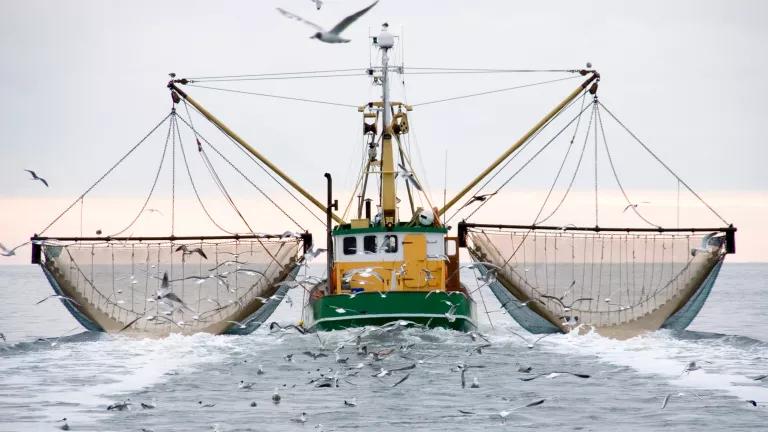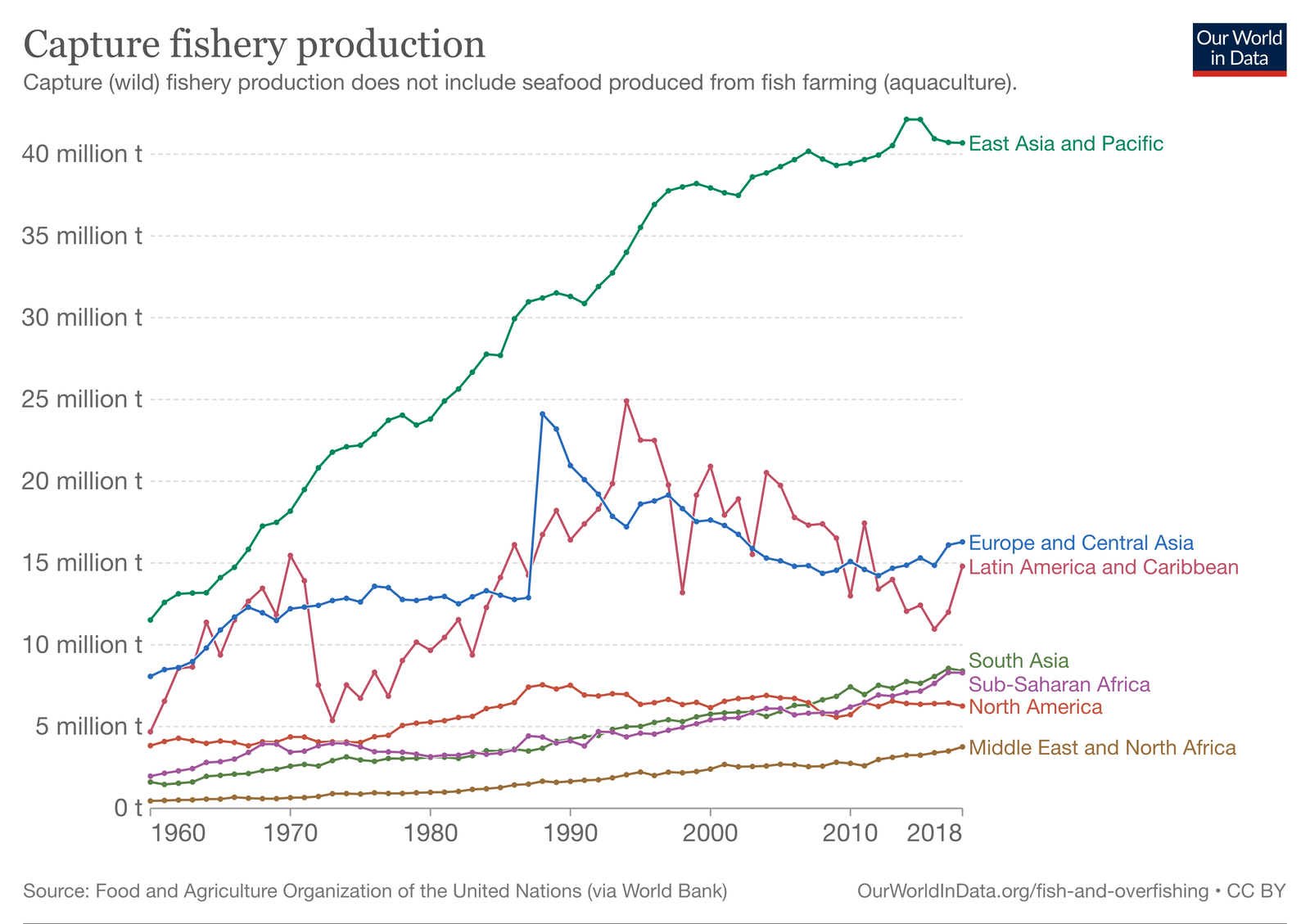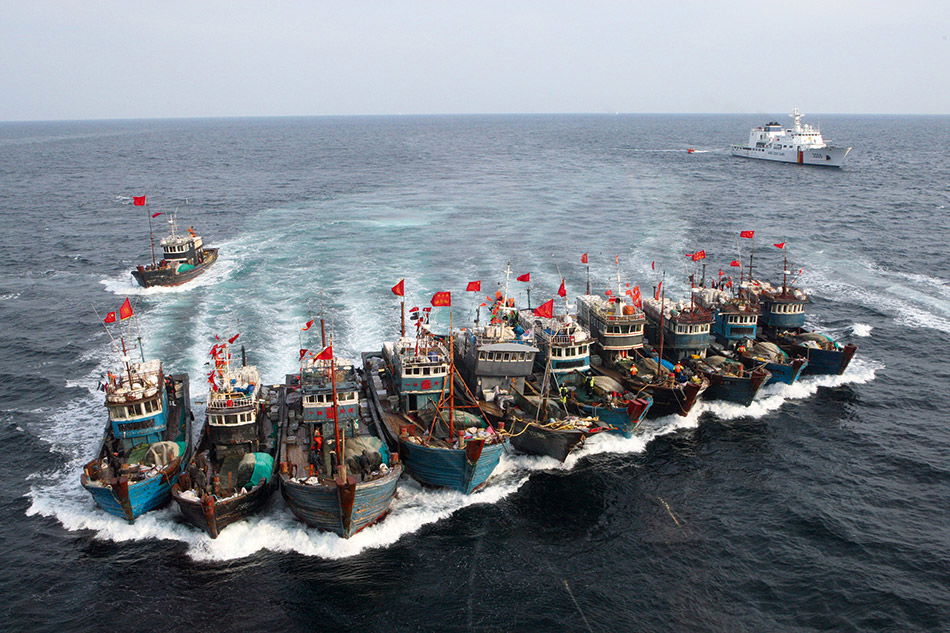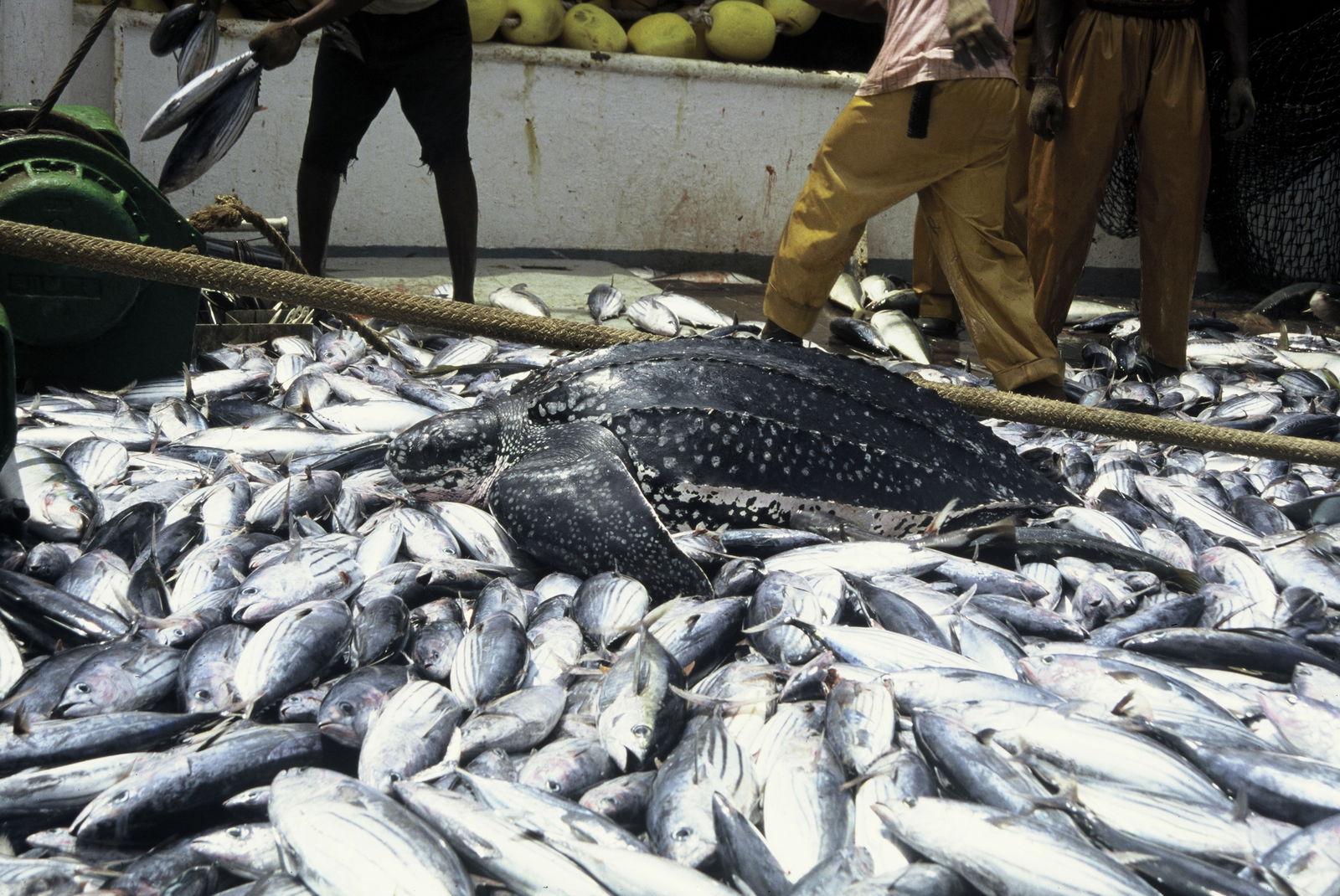Six eye-opening overfishing facts you need to know


· 13 min read
This article is part of an educational series to spread free & quality sustainability knowledge for all. Compare on Data Hub™ the sustainability performance of the largest fishery firms: Grieg Seafood and Austevoll Seafood ASA.
- Almost 90 percent of the world's assessed fisheries are fully exploited or overfished
- Annual fish consumption dwarfed global population growth from 1961 to 2016
- Nearly 40% of fish caught globally are captured unintentionally
In the vast blue expanses of our planet's oceans, a silent crisis looms, threatening the delicate balance of marine ecosystems and the very survival of countless species. This crisis is known as overfishing, a practice that has garnered increasing attention in recent years. Overfishing can be defined as the exploitation of aquatic resources beyond their sustainable limits, leading to a depletion of fish stocks and the disruption of marine ecosystems. It is not merely a concern for environmentalists and conservationists. Overfishing carries significant consequences for the global economy, food security, and the livelihoods of millions of people who depend on fisheries. As we delve into the depths of this issue, we will uncover the alarming facts that highlight the dire need for immediate action to address overfishing and protect the fragile wonders beneath the waves.

When it comes to overfishing, knowledge is power. Understanding the gravity of the issue and its far-reaching implications is crucial for raising awareness and inspiring meaningful change. In this article, we present a curated selection of the top six overfishing facts that will shed light on the magnitude of this global challenge. From staggering statistics about declining fish populations to the ripple effects on ecosystems and human communities, these facts will underscore the urgency of addressing overfishing as a priority. Prepare to be enlightened as we delve into the key realities of overfishing and the imperative to safeguard our oceans for future generations.

One of the most alarming overfishing facts that demands immediate attention is the staggering reality that nearly 90 percent of global marine fish stocks are now fully exploited or overfished. According to World Bank data, close to 90% of global marine fish stocks are either fully exploited or overfished. In addition, the Food and Agriculture Organization notes that the proportion of overfished stocks has increased over the last 40 years. Fully exploited fish stocks indicate that they are being harvested at their maximum sustainable yield, leaving little room for population growth or recovery. Overfished stocks, on the other hand, have been depleted beyond their sustainable limits, putting them at risk of collapse and jeopardizing entire ecosystems.
The implications of this high percentage of fully exploited or overfished stocks are far-reaching. It doesn't only threaten the long-term viability of fish populations but also has severe consequences for coastal communities and economies that heavily rely on fisheries for food security and livelihoods. At this rate, the world's oceans might run out of fish in the next couple of decades.

The global demand for seafood has been steadily rising, as highlighted by the fact that from 1961 to 2016, the average annual food fish consumption surpassed the rate of global population growth. This finding, reported by the Food and Agriculture Organization of the United Nations, underscores the increasing pressure on our oceans and their finite resources. While the average annual increase in population growth during this period was 1.6%, the average annual increase in global food fish consumption was 3.2%
The implications of this trend are significant. As the world population continues to grow, the strain on fish stocks intensifies. With more mouths to feed, there is a greater need for sustainable fishing practices to ensure that the demand for seafood does not lead to the depletion of fish populations or the degradation of marine ecosystems.
The fact that food fish consumption has outpaced population growth serves as a wake-up call, urging us to reevaluate our relationship with the oceans and the way we consume seafood. It highlights the urgency of promoting sustainable fishing practices, responsible aquaculture, and effective fisheries management to ensure the long-term availability of this vital food resource.
Moreover, this fact underscores the importance of exploring alternative solutions to meet the global demand for protein sources. Diversifying our diets and considering sustainable alternatives, such as plant-based proteins, can help alleviate the pressure on fish stocks while ensuring food security for the growing population.

The Pacific bluefin tuna, a commercially valuable fish that was once abundant in the vast waters of the Pacific Ocean, has fallen victim to the devastating consequences of overfishing. Shockingly, over 90% of this iconic species has been eradicated due to unsustainable fishing practices.
A 2016 report indicates that 97.4 percent of the Pacific bluefin tuna has been overfished. The implication is that only 2.6 percent remains of the original population of the Pacific bluefin tuna. Current management measures will fail to meet the already inadequate initial rebuilding plan agreed to by fishing nations in 2015.

Unregulated activities in the fishing industry are worrying. Unregulated fishing accounts for nearly 30% of fishing activities worldwide, posing a significant threat to marine ecosystems and sustainable fishing practices. Unregulated fishing refers to activities that occur outside the framework of effective management and lack adequate monitoring and control measures.
This substantial percentage of unregulated fishing has severe implications for the health and sustainability of our oceans. It undermines efforts to maintain fish populations within sustainable limits and disrupts the delicate balance of marine ecosystems.
Unregulated fishing not only depletes fish stocks but also leads to illegal, unreported, and unregulated (IUU) fishing, which exacerbates the problem. IUU fishing often involves overfishing, bycatch of non-target species, and damage to sensitive habitats, further compromising the health of marine environments.
Addressing unregulated fishing requires collaborative efforts on a global scale. Enhanced international cooperation, stronger enforcement of regulations, and the implementation of effective monitoring systems are crucial to combat this destructive practice. Additionally, promoting transparency and traceability in the seafood supply chain is essential to eliminate the market demand for illegally caught fish.

In the most basic sense of it, bycatch refers to any unwanted fish or organisms caught while fishing. In a broader sense, bycatch refers to the unintentional capture or incidental catching of non-target species during fishing operations. It occurs when fishing gear, such as nets, lines, or traps, are deployed to target a particular species but inadvertently catch fish or other marine organisms, including marine mammals that were not targeted.
Bycatch poses significant ecological and conservation concerns as it can result in the injury, mortality, or displacement of non-target species and endangered species. According to the National Oceanic and Atmospheric Administration, caught animals often suffer injuries or die, thus contributing to the depletion of their population. Nearly 40% of fish caught globally are captured unintentionally. This amounts to 38 million tonnes of sea creatures caught as bycatch annually.
Many of these species may be endangered, threatened, or have important ecological roles within marine ecosystems. Bycatch can disrupt the balance of marine food webs, reduce biodiversity, and contribute to the decline of vulnerable populations. Bycatch is a global issue affecting various fishing methods and regions. The severity of the problem varies depending on the type of gear used, fishing practices, and the target species. Bycatch reduction measures, such as the use of specialized fishing gear, modifications in fishing techniques, and the implementation of fishing regulations and marine protected areas, are implemented to mitigate the impacts of bycatch and promote more sustainable fishing practices.
On the surface, fishing subsidies look good as they make fishing easier. However, the impact can be harmful when assessed very well. Governments spend more than USD 30 billion annually to support the fishing sector. Fishing subsidies are financial incentives, including tax breaks, fuel subsidies, and access to credit, provided by governments to support the fishing industry. While intended to support sustainable fishing practices and promote the economic development of coastal communities, fishing subsidies can contribute significantly to overfishing.
One way fishing subsidies lead to overfishing is by supporting the expansion of fishing fleets and increasing fishing efforts. Subsidies can help fishing companies to purchase new vessels, upgrade equipment, and expand operations, leading to more significant fishing capacity and greater fishing pressure on fish stocks and other marine species. This increased fishing pressure can result in overfishing, where fish populations are depleted beyond their sustainable limits.
Fishing subsidies can also contribute to the overexploitation of specific species. Subsidies often prioritize and incentivize the fishing of high-value or commercially desirable species, such as tuna, cod, or shrimp, leading to the depletion of these species and the disruption of marine ecosystems. Furthermore, subsidies can support destructive fishing practices, such as bottom trawling, that damage sensitive habitats and increase the bycatch of non-target species.
According to Statista, 92.1 million metric tons of fish were caught in 2022. Also, China leads other nations as the world's largest fish producer.
Stopping overfishing requires a multi-dimensional approach, depending on the peculiarities of the problem in specific domains. Here are some steps that can be taken:
The effects of overfishing are far-reaching. Below are some of the significant effects of overfishing:
Overfishing affects climate change in many ways. One of the major ways it affects climate change is through the depletion of the Earth's carbon sink. The ocean and the life therein are one of the largest carbon sinks on Earth. Thus, overfishing can have an adverse effect on the ocean's ability to serve as a reliable carbon sink. In addition, fishing vessels operated by large-scale fishing companies contribute to CO2 emissions. Research shows that the marine fishing sector considerably contributes to global CO2 emissions and reduction plans.
According to WWF, one billion people rely on fish and seafood as their main source of protein globally.
Overfishing negatively impacts the economy by causing job losses and economic instability in fishing-dependent communities, reducing revenue for the fishing industry, and undermining the profitability of fisheries. It also leads to increased costs for fisheries management and efforts to restore depleted fish stocks, further straining the economic sustainability of the sector.
Today, the world's fish stocks suffer from overfishing, and it poses a grave threat to the health and sustainability of our oceans. The impacts of overfishing are far-reaching, from the decline of fish populations and disruption of marine ecosystems to the economic instability of fishing-dependent communities. Overfishing also has consequences for climate change, affecting carbon sequestration, altering food web dynamics, and reducing biodiversity. Urgent action is needed to address overfishing through the implementation of fishing regulations, reduction of bycatch, promotion of sustainable aquaculture, and the elimination of harmful fishing subsidies. By prioritizing sustainable fishing practices, protecting marine habitats, and fostering international cooperation, we can ensure the long-term viability of our oceans, the preservation of fish stocks, and the well-being of both marine ecosystems and human communities that depend on them.
illuminem's Data Hub™ tracking sustainability performance data of the largest fishery firms: Grieg Seafood and Austevoll Seafood ASA.
Data | The World Bank. (n.d.). https://datatopics.worldbank.org/sdgatlas/archive/2017/SDG-14-life-below-water.html
Facts & Figures: The cold hard facts about overfishing - Fish Forward (WWF). (2015, October 13). Fish Forward (WWF). https://www.fishforward.eu/sl/facts-figures/
FAO. (n.d.). The State of World Fisheries and Aquaculture. https://www.fao.org/3/i9540en/i9540en.pdf
Fisheries, N. (n.d.). Understanding Bycatch. NOAA. https://www.fisheries.noaa.gov/insight/understanding-bycatch
Greer, K., Zeller, D., Woroniak, J., Coulter, A., Winchester, M., Palomares, M. D., & Pauly, D. (2019). Global trends in carbon dioxide (CO2) emissions from fuel combustion in marine fisheries from 1950 to 2016. Marine Policy, 107, 103382. https://doi.org/10.1016/j.marpol.2018.12.001
Jdix. (2016, September 17). Supporting sustainable fishing practices. WWF. https://www.wwf.org.uk/what-we-do/addressing-unsustainable-fishing-and-seafood#:~:text=Sustainable%20UK%2C%20European%20and%20international,looked%20after%20and%20managed%20sustainably.
Many government subsidies lead to overfishing. Here’s a solution. - OECD. (n.d.). https://www.oecd.org/agriculture/government-subsidies-overfishing/
Nickson, A. (2016). New Science Puts Decline of Pacific Bluefin at 97.4 Percent. The Pew Charitable Trusts. https://www.pewtrusts.org/en/research-and-analysis/articles/2016/04/25/new-science-puts-decline-of-pacific-bluefin-at-974-percent
Plenty of Fish? | UNFCCC. (n.d.). https://unfccc.int/blog/plenty-of-fish
Statista. (n.d.). Statista - The Statistics Portal. https://www.statista.com/markets/421/topic/497/fisheries-aquaculture/#statistic2
illuminem briefings

Labor Rights · Climate Change
illuminem briefings

Architecture · Carbon Capture & Storage
Barnabé Colin

Biodiversity · Nature
Euronews

Degrowth · Public Governance
Politico

Public Governance · Climate Change
Mongabay

Climate Change · Environmental Rights